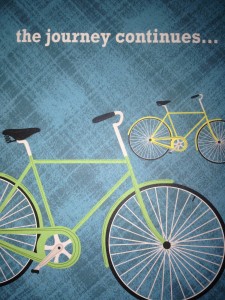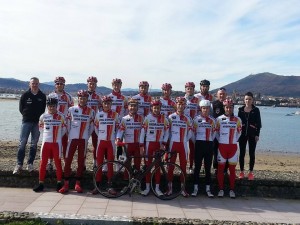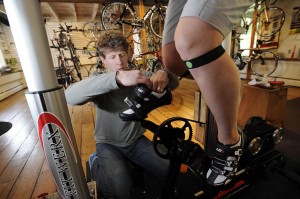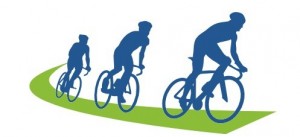Every rider deserves a bike that fits, a bike that is made for him or her, a custom cycle.
I hurried out the door of the Seven Cycles factory in Watertown, MA, intent on beating Friday afternoon rush hour traffic. With visions of bicycles dancing in my head, I heard a voice with jovial Irish accent calling out to me. (It was near Boston, after all.) “Getting ready for the Tour de France,” he shouted, then laughed hilariously. Really.
Putting aside the obvious, (I have neither youth nor gender to compete in the Tour), what did he mean? I’m not good enough for a custom bike? And THAT is the misconception.
Just what is a custom bike? When you couple the words bespoke (made to order) and bike you have a custom bike. A stock bike (think Specialized, Trek, Canondale, LLBean; that long row of bikes hanging in your local sporting goods store) comes with frame already sized and materials already chosen for you. Your options include shop modifications to what is available and a range of prices based on materials and components.
A bespoke bike is built from top to bottom for a specific rider. Measurements and angles fit the individual, materials are selected from steel to carbon-fiber composite frames, titanium and even bamboo. Components, or the miscellaneous parts of the bike that transform it from a diamond-shape to a bike on wheels with gears and brakes, are pieced together in a way that completes the puzzle of the unique. Then there’s appearance where one can go wild with individualization.
Before I launch into the virtues of a custom bike, note my disclaimer. I am relatively new to cycling (5 years is new in a sport that lasts a lifetime) but passionate. I love the training as well as the freedom, the cycling buddies I have acquired as well as concerns. I am neither an accomplished athlete nor a couch potato and my 20s and 30s are far behind me. I have had surgery that makes cycling a better choice than running. My strength is endurance not power, my time is restricted by work and I am anxious about dangers. Yet I have goals and dreams that I hope to achieve.
Because of my love for cycling, I sincerely believe that ANY bike that provides enjoyment, that puts you on the road or the trail, is a good bike. Though a case can be made for the similar costs of a custom built bike and a high end stock bike, if one’s budget (or values) simply forbid a custom, well, so be it. Just get out there on whatever you’ve got and be happy.
After riding two stock bikes that simply weren’t right for me, I took the next step, a bike built to meet my specific needs.
I ride a Seven. (Note, Seven is just one of many reputable, excellent makers of custom bikes. I can speak from personal experience and so use Seven as subject.) 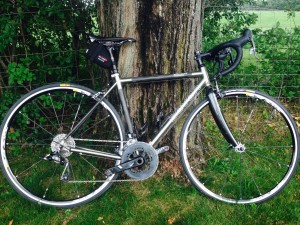 An impeccable bike fit by Ian Buchanan at FitWerx in Waitsfield along with his perfect guidance in selecting the right components, resulted in a bike that is unpretentious but, from the first pedal stroke, confirmed the wisdom that a bespoke bike is the way to go for some, for those of us who can define what we need in a bike, can assess what is wrong with the stock bike that we are riding, and how much we are willing to invest in time, effort and budget. Until you know what you are looking for and are willing to prioritize, you’re not ready.
An impeccable bike fit by Ian Buchanan at FitWerx in Waitsfield along with his perfect guidance in selecting the right components, resulted in a bike that is unpretentious but, from the first pedal stroke, confirmed the wisdom that a bespoke bike is the way to go for some, for those of us who can define what we need in a bike, can assess what is wrong with the stock bike that we are riding, and how much we are willing to invest in time, effort and budget. Until you know what you are looking for and are willing to prioritize, you’re not ready.

Seat Post
If I had to summarize in one word what my new Seven has given me, it is confidence. This confidence is the result of an ongoing process, but the bike sure helps.
Seven Cycles is know for the select, high-end frames built in their small New England factory. Are these bikes built only for the competitive cyclist or the super rich? More and more the answer is a resounding “NO.”
“Custom is not about the pro,” Rob Vandermark said. Vandermark, founder and president of Seven Cycles, is also inextricably involved with product development, always searching for the next bike, the next use.
“A custom bike is much more than just fit,” Vandermark said. “It is a path to being a stronger climber, riding that first century or 3-day tour, avoiding injury. It is a path to making the best possible [cycling] experience.”
Custom drives performance, comfort and safety. Performance defines custom.
Anyone who spends hours in the saddle, who can’t wait to get outdoors to ride, whose passion fuels the necessary effort and whose idea of heaven is balanced on two wheels, deserves a custom bike, one that is built specifically for him or her.
Building a bike customized to an individual is a team effort. “Fit is a small slice,” Vandermark said, “10% of the value. For the majority, rarely is fit the primary driver. It’s more about use.” Also important to customers is paint and appearance that makes the bike unique.
While I understand what Vandermark is saying, and certainly he knows his customers, I find that here on Vermont roads and in our cycling community, fit is very important. Perhaps, however, we are saying the same thing.
Fit is more than measurements. Fit is a rider profile of body type, age, fitness, athleticism, flexibility, strength, goals, type of riding, where, how often and even attitude. (Is the rider competitive or recreational, audacious or timid, brazen or anxious?) Perhaps this is, after all, what Vandermark calls “use.”
A committed rider “deserves” a bike designed and built to address his needs, wants, apprehensions and strengths. Such a bike helps that rider to achieve success, maximize time and enjoyment, and ride in such a way that his body functions harmoniously throughout hundreds of thousands of repetitive pedal strokes.
To write in detail about building a bike, I would need to write a book. It’s been done. I recommend Robert Penn’s “It’s All About the Bike.” Penn writes in eloquent detail about the frame, the soul of the bike, as well as the components, materials and design of his dream bike. He dismisses bragging rights about weight, but speaks convincingly of the geometry of the frame that “sets the parameters…Get the geometry of the frame wrong and you could end up with a bike that is at best uncomfortable, and at worst, dangerous to ride. Get it right, and the bike will have the handling characteristics you desire.”
At Seven Cycles, for example, Five Elements of Customization are clearly spelled out. Fit, includes comfort and injury management; handling and performance means that the bike is tuned for the way you are going to ride; tubing and materials are tailored to meet the riders’ needs; there is an infinite array of features and options from which to choose; and finally, the future. How well have you planned for years down the road?
Where a bike is built from the beginning, there is no stock, no inventory. At Seven Cycles, employees (clearly cyclists; note the “commuter parking lot,” an eclectic collection of bikes parked in the backroom) work with one bike at a time from start to finish, conception to shipping room.
Because I was already in love with my bike, my visit to the Seven factory (tours are available to anyone who wants to schedule) was not needed to convince, but to inform and confirm. It did. There’s nothing slick about this place. Thankfully. It is a place in which men and women are artists and take seriously their role in making dreams possible. A bike begins with a box of unrecognizable things and a manila folder with specs and notes pertaining to that one and only bike-to-be. From step one the contents of the box/folder become an identity. The resulting frame is meticulously crafted, painstakingly checking alignment and welding perfection until, in the final analysis, the frame is inspected and tested by “The Enforcer.” If any part is found wanting, there is no patch. The build begins again.
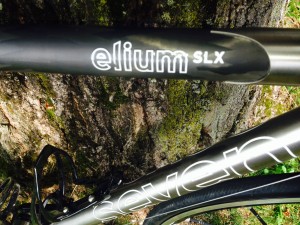
Frame
Vandermark, engaging, enthusiastic and immediately comfortable, brings to Seven Cycles a mix of savvy yet ardent practices and technical skills. His own background as a sculptor and mountain bike racer drive the confluence of art and science in both his bike and business design.
It is foolish to think that a bespoke roadbike frame is the total story. In fact, Vandermark has cycled his way along routes from city traffic to the open roads, from deep woods and challenging trails to racing and casual sojourns. Based on personal experience, and always open to new horizons, Vandermark has designed bikes to accommodate a variety of purposes and riding styles. From road and mountain bikes, to cyclocross, gravel, and future travel bikes, Vandermark keeps his proverbial finger on the pulse of cycling trends. And each is built for the individual.
A candidate for a custom bike must be willing to make informed choices. A bespoke bike has a price tag. For some it might be equivalent of a monthly mortgage payment, or possibly even the cost of the entire house that one’s grandparent purchased way back when.
Extravagantly selected options could lead to an unaffordable purchase. On the other hand, the custom process allows a rider to weed out the extras that are inappropriate or irrelevant. For example, on my own bike I reduced the cost by eliminating a paint job, and choosing components that are sufficient to meet my needs and no more.
Furthermore, an avid cyclist often lusts for new and different bikes. Once one is built for him or her, there is no need to keep shopping. Perhaps, in the long run, a bespoke bike is the economical approach after all.
But, the bottom line is choice. If riding is what you choose to do and what inspires and gladdens your heart, giving yourself the best possible experience with a custom bike might just be the sugarplum that dances in your head during this and every cycling season to come.





